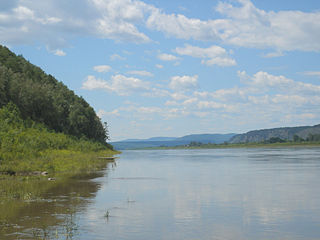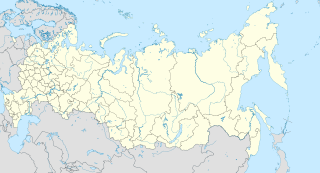Coordinates: 51°05′48″N138°28′19″E / 51.09667°N 138.47194°E

A geographic coordinate system is a coordinate system that enables every location on Earth to be specified by a set of numbers, letters or symbols. The coordinates are often chosen such that one of the numbers represents a vertical position and two or three of the numbers represent a horizontal position; alternatively, a geographic position may be expressed in a combined three-dimensional Cartesian vector. A common choice of coordinates is latitude, longitude and elevation. To specify a location on a plane requires a map projection.
Chyorny Mys (Russian :Чёрный Мыс, lit. black cape) is a rural locality (a selo ) in Komsomolsky District of Khabarovsk Krai, Russia. Population: 200 (2011 est.). [1]

Russian is an East Slavic language, which is official in the Russian Federation, Belarus, Kazakhstan and Kyrgyzstan, as well as being widely used throughout Eastern Europe, the Baltic states, the Caucasus and Central Asia. It was the de facto language of the Soviet Union until its dissolution on 25 December 1991. Although, nowadays, nearly three decades after the breakup of the Soviet Union, Russian is used in official capacity or in public life in all the post-Soviet nation-states, as well as in Israel and Mongolia, the rise of state-specific varieties of this language tends to be strongly denied in Russia, in line with the Russian World ideology.
The classification system of the types of inhabited localities in Russia, the former Soviet Union, and some other post-Soviet states has certain peculiarities compared with the classification systems in other countries.

Komsomolsky District is an administrative and municipal district (raion), one of the seventeen in Khabarovsk Krai, Russia. It is located in the southern central part of the krai. The area of the district is 25,167 square kilometers (9,717 sq mi). Its administrative center is the city of Komsomolsk-on-Amur. Population: 29,072 (2010 Census); 31,563 (2002 Census); 33,649 (1989 Census).
It is located on the right bank of the Amur River, about 120 kilometers (75 mi) downstream from Komsomolsk-on-Amur. It was the furthest operational point of a branch railway from Selikhino built in the early 1950s by the Soviet Union under Joseph Stalin, intended to link to a tunnel to the island of Sakhalin. Construction of the tunnel was abandoned after Stalin's death; however, the section as far as Chyorny Mys had been completed and was kept open for logging industry traffic until the 1990s.

The Amur River or Heilong Jiang is the world's tenth longest river, forming the border between the Russian Far East and Northeastern China. The largest fish species in the Amur is the kaluga, attaining a length as great as 5.6 metres (18 ft). The river basin is home to a variety of large predatory fish such as northern snakehead, Amur pike, taimen, Amur catfish, predatory carp and yellowcheek, as well as the northernmost populations of the Amur softshell turtle and Indian lotus.

Komsomolsk-on-Amur is a city in Khabarovsk Krai, Russia, located on the left bank of the Amur River in the Russian Far East. It is located on the Baikal-Amur Mainline, 356 kilometers (221 mi) northeast of Khabarovsk. As of 2010, it had a population of 263,906 (2010 Census); 281,035 (2002 Census); 315,325 (1989 Census).
Selikhino is a rural locality in Komsomolsky District of Khabarovsk Krai, Russia. Population: 4,255 (2010 Census); 4,865 (2002 Census).









